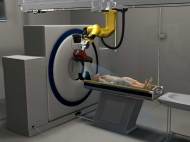Virtobot performs virtual autopsies to preserve bodies digitally
 Ever since the CSI TV series hit the airwaves, everyone knows that forensic doctors use various techniques and high-tech tools in order to reconstruct how the crime or accident happened. We already wrote about interactive 3D virtual autopsy table which serves to show the images, but Virtobot is a forensic high-tech helpmate used at the University of Bern’s Institute of Forensic Medicine to perform virtual autopsies and provide such images.
Ever since the CSI TV series hit the airwaves, everyone knows that forensic doctors use various techniques and high-tech tools in order to reconstruct how the crime or accident happened. We already wrote about interactive 3D virtual autopsy table which serves to show the images, but Virtobot is a forensic high-tech helpmate used at the University of Bern’s Institute of Forensic Medicine to perform virtual autopsies and provide such images.
A high-mobility industrial robot Virtobot records the contours of a cadaver under examination and uses computed tomography at the same time in order to provide forensic doctors with a three-dimensional image. The data is storable digitally so it can be used for further reference or evidence many years later.
In the “Virtopsy” laboratory, forensic autopsy techniques are undergoing further development. The coinage “virtopsy” stands for virtual autopsy and describes post-mortem examinations that are performed without cutting open the body of the deceased and solely on the basis of high definition magnetic resonance imaging (MRI) and computer tomography (CT).
In the Virtopsy laboratory, Virtubot projects a light bar onto the corpse being examined. The imaged body contours are recorded in high definition using a digital stereo camera. At the same time, the Virtobot images the texture of the skin. “Then we harmonise these surface images with the three-dimensional CR data of the entire body”, explains Lars Ebert, who programmed Virtobot as part of the National Centres of Competence in Research, Co-Me. Forensic doctors are thus provided with a high-precision, three-dimensional image of the body and can examine it on-screen from all angles, both externally and internally.
This combination of medical imaging, surgical navigation and robotics means that for the first time ever cadavers can be digitally preserved and autopsies conducted again, even years later, for instance when new evidence is turned up in an unsolved case.
Digitally captured data have meanwhile been approved as evidence in the courts, but only when validated by a conventional autopsy. It is still needed until we find a way to capture the exact state, including the chemicals and the usual colorations which point to potential causes of death or evidence.









Leave your response!